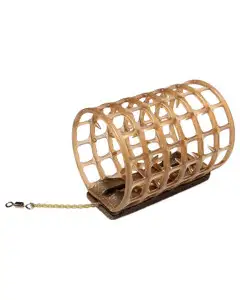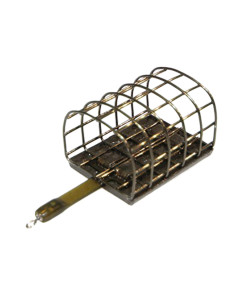This is a demo store. No orders will be fulfilled.
Master the Art of Feeder Fishing: Top 5 Rigs for Success
This entry was posted on by Anna Cooper

Feeder fishing, ever heard of it? If you're new to the coarse fishing scene, this term might sound a bit puzzling. Luckily, we are going to explain what feeder fishing is, the types of feeders, feeder rigs and some useful fishing tips.
Feeder fishing is a popular type of angling. It involves luring fish by providing them with a continuous supply of fishing bait. This bait is distributed by fishing feeders.
What is Feeder Fishing?
Feeder fishing is a bait application method that keeps fish, like carp, in an area by providing free bait constantly. This technique deposits a lot of fishing bait. It also adds fresh appeal to your swim. This is something that catapults and throwing sticks cannot do.
Selecting the right feeder for your fishing tactics and venue can be challenging due to the wide variety available. Here are some popular feeder types to consider:


Block-end Feeder: Also known as a Maggot Feeder, this enclosed capsule is designed for live baits. The bait slowly escapes through small holes, making it perfect for running water.


Open-Ended Cage Feeder: This solid plastic feeder is ideal for groundbait in shallow and deeper waters. It features drilled holes for a rapid bait release.


Cage Feeder: Designed for fast groundbait release, this mesh or metal cage feeder is ideal for shallow water.


Method Feeder: Best used when fish are competing for food. The Method Feeder allows you to pack groundbait around its core before casting.


Feeder Bombs: These weighted feeders are perfect for long-distance casts targeting specimen roach and bream.


Alloy/Hybrid Feeder: Smoothly designed for optimal casting, its holes and slits allow for a quick but controlled bait breakdown.


Pellet Feeder: Blocked at one end. This feeder lets you push soft baits, like pellets and corn, into its cage before casting.
Best Feeders for Fishing
Master these 5 feeder fishing rigs to improve your chances of success:
1. Running Rig
Simple and effective. The running feeder fishing rig is ideal for venues with plenty of fish and works well with plastic or cage feeders.


2. Captive Running Rig
Similar to the running rig, this setup has a stopper on the mainline. It is perfect for when you can't strike immediately.


3. Paternoster Rig:
Great for Stillwater venues, this rig is a favourite among bream anglers for its bite-detection capabilities.


4. Method Feeder Rig:
Used as a feeder fishing rig for carp, tench, and bream. The Method rig lets you deliver bait parcels without tangles.


5. Helicopter Feeder Rig:
An ideal feeder fishing rig for rivers. Use for unmissable bites and diverse species. This feeder rig for river fishing works well with maggot, block-end, and method feeders.


1. Choose the right feeder and bait for the conditions and species you're targeting.
2. Cast accurately with your feeder rod and consistently to build up a baited area that will attract fish.
3. Be patient and wait for the fish to find your bait. Don't be tempted to reel in the feeder too soon.
4. Practice your rig-tying skills. A well-tied rig can significantly increase your chances of success.
5. Use PVA tape to slow down the bait release rate by covering some holes.
Hone Your Feeder Fishing Skills
To take your feeder fishing to the next level, check out Stephen Crowe's Guide to Feeder Fishing. Follow the video tutorial on how to tie the perfect feeder rig.
Feeder fishing is a fascinating and rewarding method of angling. It offers a strategic approach to luring and catching fish.
Anglers of all experience levels can benefit from learning about feeders and how to set them up. This knowledge can improve your fishing experience. So, why not give it a try on your next fishing trip?


Don't hesitate to visit your local angling store or contact our support team for more advice. Share your favourite feeder fishing rig and tips with us on social media!
FAQs about Feeder Fishing
What is the best bait for feeder fishing?
The best bait varies depending on the species you're targeting. Common choices include maggots, pellets, and groundbait.
How long should the hooklength be in feeder fishing?
The hooklength is typically between 1 and 2 feet. It can be adjusted depending on the fishing conditions and the fish's behaviour.
Can I use feeder fishing in any type of water?
Yes, feeder fishing can be used in various types of water, including lakes, rivers, and commercial fisheries.
What is the main advantage of using a method feeder?
A method feeder has a major benefit. It displays the bait in a small, attractive form that is difficult for fish to ignore.
What is the difference between an open-end feeder and a block-end feeder?
The main difference is how they release bait. Open-end feeders release bait slowly, while block-end feeders retain the bait longer, making them suitable for different fishing conditions.













